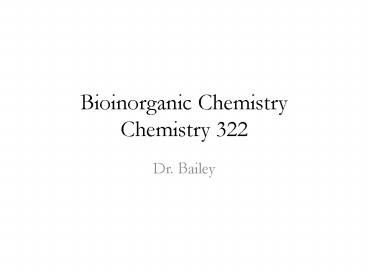Bioinorganic Chemistry Chemistry 322 - PowerPoint PPT Presentation
1 / 12
Title:
Bioinorganic Chemistry Chemistry 322
Description:
Bioinorganic Chemistry Chemistry 322 Dr. Bailey What is Bioinorganic Chemistry? interface between chemistry and biology aka Inorganic Biochemistry study of the ... – PowerPoint PPT presentation
Number of Views:403
Avg rating:3.0/5.0
Title: Bioinorganic Chemistry Chemistry 322
1
Bioinorganic ChemistryChemistry 322
- Dr. Bailey
2
What is Bioinorganic Chemistry?
- interface between chemistry and biology
- aka Inorganic Biochemistry
- study of the structure and function of inorganic
ions in biological systems - how inorganic species function in vivo
- Which metals are utilized?
- Na, Mg, K Ca
- V, Cr, Mn, Fe, Co, Ni, Cu, Zn, Mo (our focus)
3
Gross Classification of Bioinorganic Systems
- Metalloproteins (largest group)
- transport storage (both metal and substrate)
- enzymes (biological catalysts)
- Non-proteins
- smaller molecules (non-amino acid based) that
perform some biological function involving metal
ions - e.g. siderophores (bind and transport iron for
microbial systems) and chlorophyll (involved in
photosynthesis) - Pharmacology and Toxicology
- utilize or try to eliminate metal ions not listed
above
4
Examples of Metal Functions
- Dioxygen Transport (Lewis Acid/Base)
- respiration uniquely performed by metalloproteins
- hemoglobin/myoglobin (Fe)
- 1Fe 1 O2
- hemocyanins (Cu) in mollusks and arthropods
- 2Cu 1 O2
- hemerythrin (Fe) in marine invertebrates (e.g.
worms) - 2Fe 1 O2
- in each, O2 molecule binds to the metal
reversibly. - note nature uses different metals in different
organisms to carry out identical function.
5
Examples of Metal Functions
- Electron Transfer
- e.g. Fe-S clusters
- protein undergoes redox transformation without
itself catalyzing an overall chemical change in
the substrate - so, just passing electrons to/from enzymes that
require redox chemistry - Structural
- metal holds amino acids in a particular
conformation - e.g. zinc fingers in nucleic acid binding
proteins - Metal Ion Transport and Storage
- siderophores --- bacterial/fungal iron transport
- transferrin --- vertebrate iron transport
- ferritin --- vertebrate iron storage
- ceruloplasm --- copper transport in mamalian
blood plasma
6
Examples of Metal Functions
- Metalloenzymes
- hydrolytic enzymes
- catalyze addition or removal of water in a
substrate - e.g. carbonic anhydrase catalyzes CO2 H2O ?
H2CO3 - redox enzymes
- catalyze oxidation/reduction of substrate
- e.g. oxidation of hydrocarbons to alcohol by
cyt-P450 (Fe-porphyin) - e.g. nitrogenase reduces N2 to NH3 (6 electron
transformation) - rearrangements
- biological transformation without change in
oxydation state of the substrate. - metal acts as template
7
Why Are Certain Metal Ions Involved?
- Rule of Abundance
- when a process can be accomplished using any of
several metal ions, then the molecule will pick
the most abundant ion - e.g. Ca2 and Sr2 carbonate/phosphate compounds
equally insoluble. Why arent bones made from Sr?
(Ca is much more abundant) - e.g. Zn enzymes can use Co2 effectively, but
chose Zn because it is much more abundant
8
Why Are Certain Metal Ions Involved?
- Rule of Efficiency
- an organism will utilize the most efficient ion
if two are in equal abundance - e.g. two electron carriers
- flavodoxins (-0.185V potential) with no metal ion
- ferridoxins (-0.420V) Fe-S metalloenzyme
- both are similar in function, but the ferridoxins
are much more efficient and powerful than the
flavodoxins and are therefore employed more
9
Why Are Certain Metal Ions Involved?
- Rule of Basic Fitness (Most Important!)
- no matter how abundant an ion is, if it cant do
the job it isnt going to be used. - the ion has to function in an aqueous solution at
neutral pH and 25oC, so most jobs can only be
performed by a limited number of ions.
10
Why Are Certain Metal Ions Involved?
- Rule of Basic Fitness (Most Important!)
- see e.g. Figure 1 from Ochiai
- dotted lines represent redox potentials of water
at various pH values - other lines show reduction potential for several
metal ion couples - what may be inferred is that species whose
reduction potentials lie outside of the
decomposition lines of water would either oxidize
or reduce water and would not be suitable for
roles in aqueous media. - e.g. Co(III)/Co(II) Sn(IV)/Sn(II) and
Cr(III)/Cr(II) systems are probably not good as
redox catalysts (enzymes).
11
Why Are Certain Metal Ions Involved?
- Rule of Basic Fitness (Most Important!)
- another example involving two different modes for
binding dioxygen - O
- M O2 ? M-O ?Ga
- M M O2 ? M M ?Gb
- in order for these reactions to be useful they
must be reversible in order for them to be
reversible ?G must be between -2 and -12 - if ?G gt -2, forward reaction is not occurring
enough - if ?G lt -12, then O2 will never come off
O O
- for ?Ga mechanism Fe(II) and Co(II) are only
ones that can be used (in fact, known examples do
use these metals e.g. hemoglobin) - the ?Gb
mechanism can occur with Fe(II), Co(II) or Cu(I)
12
Why Are Certain Metal Ions Involved?
- Evolutionary Improvement
- if a system is working, then evolution will try
and make the system more efficient. - this is controlled solely by the protein
environment and not by the metal - thus any naturally occurring metalloprotein will
be much more efficient than any smaller system we
might devise - Vallee Entatic State
- active site of metalloproteins are often highly
distorted, and are closer to the transition state
than small metal system. - e.g. copper blue proteins Cu(II) sq. planar ? Cu
(I) tetrahedral - actual structure is distorted square planar
(between sq. planar and tetrahedral)































